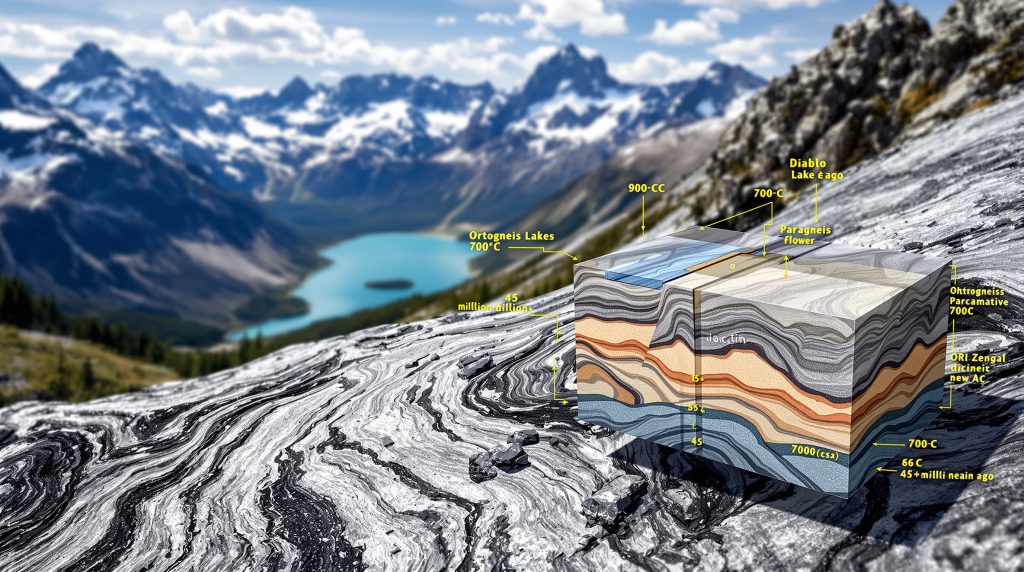Understanding the Skagit Gneiss Complex: Geological Marvel of the North Cascades
The Skagit Gneiss Complex represents one of North America's most fascinating geological formations, providing geologists with an exceptional window into deep crustal processes that shaped the western United States. Located within Washington's North Cascades, this metamorphic terrain reveals intricate patterns of deformation, magmatism, and crustal evolution spanning millions of years. Its distinctive rock compositions and significant role in forming the region's breathtaking landscape make it a geological treasure trove that continues to yield important scientific discoveries.
What is the Skagit Gneiss Complex?
The Skagit Gneiss Complex constitutes a vast expanse of metamorphic rocks forming the crystalline core of the North Cascades. This formation primarily consists of orthogneiss (metamorphosed igneous rocks), paragneiss (metamorphosed sedimentary rocks), and migmatites (partially melted rocks) that developed within a continental magmatic arc over an extended geological timeframe.
The complex stands as one of the highest-grade metamorphic terrains in the region, with rocks that experienced extreme temperatures and pressures corresponding to depths of 20-30 kilometers beneath the Earth's surface. These intense conditions transformed original igneous and sedimentary materials into the banded, foliated gneisses that characterize the complex today.
Key Rock Types and Compositions
The Skagit Gneiss Complex displays remarkable lithological diversity, reflecting its complex formation history:
-
Orthogneiss: Predominantly tonalitic to granodioritic in composition, these rocks originated as plutonic igneous bodies that were subsequently metamorphosed. They typically contain plagioclase, quartz, biotite, and sometimes hornblende, with distinctive banding patterns formed during deformation.
-
Paragneiss: Derived from sedimentary protoliths, these rocks preserve evidence of their sedimentary origin despite intense metamorphism. They often contain aluminous minerals like garnet, sillimanite, and kyanite that formed during high-grade metamorphism.
-
Migmatites: These partially melted rocks display characteristic segregation between light-colored leucosomes (crystallized melt) and darker melanosomes (residual material). Their presence indicates that temperatures reached conditions sufficient for partial melting.
-
Leucocratic orthogneiss: Younger, light-colored orthogneiss units with lower proportions of mafic minerals, representing later magmatic pulses that intruded the complex.
How Did the Skagit Gneiss Complex Form?
The formation of the Skagit Gneiss Complex represents a fascinating chapter in the tectonic evolution of western North America. Its development occurred through multiple phases of magmatism, metamorphism, and deformation spanning tens of millions of years.
Magmatic Flare-Up Events
Field research has identified two distinct magmatic flare-up periods that contributed significantly to the formation of the Skagit Gneiss Complex:
-
Late Cretaceous Flare-Up (approximately 79-73 Ma): This older phase introduced tonalitic magmas that would later become the tonalitic orthogneisses forming much of the complex. These intrusions occurred during a period of active subduction along the western margin of North America.
-
Paleocene Flare-Up (approximately 60-55 Ma): A younger phase brought leucocratic (light-colored) orthogneiss intrusions into the already metamorphosed complex. These younger intrusions often crosscut older structures but subsequently experienced their own deformation.
These magmatic pulses contributed tremendous heat to the middle and lower crust, driving metamorphic reactions and creating conditions favorable for partial melting in the deepest portions of the complex.
Progressive Metamorphism and Migmatization
As magmatic activity intensified, the rocks of the Skagit Gneiss Complex experienced progressive metamorphism under amphibolite to upper amphibolite facies conditions. This metamorphism transformed the original igneous and sedimentary rocks into gneisses with distinctive mineral deposit tiers guide reflecting high-temperature conditions.
In the deepest portions of the complex, temperatures exceeded the solidus (melting point) for water-saturated crustal rocks, leading to partial melting and the formation of migmatites. This migmatization process fundamentally altered the rheological properties of the crust, making it weaker and more susceptible to ductile deformation.
Multiple Deformation Phases
The structural evolution of the Skagit Gneiss Complex involved multiple phases of deformation that created the complex folding patterns and fabrics observed today:
-
Early Foliation Development: Initial deformation produced a penetrative foliation (alignment of minerals) throughout much of the complex.
-
Non-Coaxial Shearing: Subsequent deformation involved significant non-coaxial shear, creating strong linear fabrics with predominantly northwest-directed movement.
-
Upright Folding: Later deformation produced kilometer-scale upright folds that affected earlier structures and fabrics.
-
Late-Stage Deformation: The youngest deformation events included both sinistral (left-lateral) and dextral (right-lateral) shearing, reflecting changing regional stress patterns.
Microstructural analysis reveals evidence for both high-temperature (>450°C) and low-temperature (300-400°C) ductile deformation, distributed in different domains throughout the complex. This temperature variation reflects the complex thermal history of the region and the interplay between magmatic heating and deformation processes.
What Makes the Skagit Gneiss Complex Scientifically Significant?
The Skagit Gneiss Complex holds exceptional scientific value for several reasons that continue to attract researchers from around the world.
Window into Deep Crustal Processes
Few places on Earth provide such clear exposure of mid-to-lower crustal rocks that have experienced the full range of processes operating in continental magmatic arcs. The Skagit Gneiss Complex offers researchers a natural laboratory for studying:
-
The interplay between magmatism and metamorphism in continental arcs
-
Mechanisms of crustal flow and deformation at high temperatures
-
Processes of partial melting and melt migration in the middle crust
-
The structural evolution of continental margins during subduction
Chronological Record of Arc Evolution
Through precise geochronological studies, researchers have established a detailed timeline of events within the Skagit Gneiss Complex. This chronological framework allows scientists to correlate processes within the complex to broader tectonic events affecting western North America during the Late Cretaceous and early Cenozoic periods.
The complex preserves evidence of how continental arcs respond to periods of intense magmatic activity and how such activity influences crustal rheology and structural development. The timing relationships between different rock units, deformation events, and metamorphic episodes provide crucial constraints for understanding the evolution of the entire North American Cordillera.
Insights into Crustal Thickening Mechanisms
Recent field research on the Skagit Gneiss Complex has yielded important insights into mechanisms of crustal thickening in continental arcs. Geochemical proxies for crustal thickness suggest that significant thickening occurred relatively late in the complex's evolution, following major magmatic pulses rather than preceding them.
This finding has important implications for understanding what drives high-flux magmatic events in continental arcs. Rather than crustal thickening triggering increased magmatism, the evidence suggests that magmatism may have weakened the crust, facilitating tectonic thickening through underthrusting of fore-arc materials into the weakened arc.
How Does the Skagit Gneiss Complex Shape the Modern Landscape?
Beyond its geological significance, the Skagit Gneiss Complex plays a fundamental role in shaping the spectacular landscape of the North Cascades region that attracts visitors from around the world.
Glacial Interaction and Scenic Features
The resistant nature of the gneissic bedrock, combined with intense glaciation during the Pleistocene and ongoing alpine glaciation, has created the dramatic topography that characterizes the North Cascades. The complex serves as the foundation for numerous glaciers, including Boston Glacier, a major glacier in the North Cascades National Park Complex.
The interaction between glacial processes and the underlying gneiss bedrock creates one of the most visually striking features of the region: the distinctive turquoise color of Diablo Lake and other glacially-fed water bodies. This remarkable coloration results from glacial flour—fine silt produced when glacial ice grinds the Skagit gneiss into powder under tremendous pressure.
The specific mineral composition of the gneiss contributes to the characteristic green hue to the suspended particles, creating the shimmering appearance that makes Diablo Lake one of the most photographed natural features in the Pacific Northwest.
Influence on Regional Hydrology
The Skagit Gneiss Complex significantly influences regional hydrology through its control on groundwater movement, spring locations, and river patterns. The complex pattern of foliation, fractures, and compositional variations within the gneiss creates preferential pathways for water movement that determine where springs emerge and how surface water interacts with groundwater.
The relatively impermeable nature of much of the gneiss contributes to the region's abundant surface water resources, with numerous lakes, streams, and waterfalls forming where water encounters resistant gneissic bedrock. These water features not only enhance the scenic beauty of the North Cascades but also provide critical habitat for numerous aquatic species.
What Recent Research Reveals About the Skagit Gneiss Complex
Modern analytical techniques and interdisciplinary approaches have yielded new insights into the Skagit Gneiss Complex, refining our understanding of its formation and evolution.
Precise Geochronology and Thermal History
Advanced geochronological techniques, including U-Pb dating of zircon and titanite, have provided unprecedented precision in determining the timing of key events in the complex's history. Field research has revealed that:
-
The oldest orthogneiss units formed around 76-79 million years ago
-
A significant pulse of leucocratic orthogneiss intrusion occurred around 60-59 million years ago
-
Distinctive "flecker" dikes with characteristic titanite-plagioclase textures formed during a restricted time interval between 49.1 and 47 million years ago
Hafnium isotopic analyses of zircons are providing new insights into the sources of magmas that contributed to the complex, helping researchers determine whether melts originated primarily from the mantle or from crustal sources.
Deformation Timing and Kinematics
Structural analysis combined with geochronology has revealed a complex history of progressive deformation spanning tens of millions of years. Recent studies have identified:
-
Evidence for early sinistral (left-lateral) shearing followed by later dextral (right-lateral) movement
-
A transition in deformation style occurring during the Eocene (around 55-50 million years ago)
-
Spatial variations in deformation intensity and style across the complex
These findings challenge simplistic models of regional deformation and suggest that the Skagit Gneiss Complex experienced a complex history of changing stress regimes related to evolving plate boundary conditions along the western North American margin.
Relationship Between Magmatism and Crustal Thickening
A key question in understanding continental arc systems concerns the relationship between magmatism and crustal thickening. Recent research on the Skagit Gneiss Complex suggests that:
-
Significant magmatism preceded major crustal thickening rather than following it
-
Magmatic activity likely weakened the crust, facilitating tectonic thickening through underthrusting
-
Sedimentary material was incorporated into the arc relatively late in its evolution, toward the end of major pluton crystallization
Geochemical data, including neodymium isotopic signatures, indicate that the magmas that formed the Skagit orthogneisses did not show strong sedimentary signatures, suggesting limited involvement of sedimentary material in magma generation during the early stages of arc development.
How Does the Skagit Gneiss Complex Compare to Other Metamorphic Terrains?
The Skagit Gneiss Complex shares similarities with other deep-crustal metamorphic terrains worldwide but also possesses unique characteristics that make it particularly valuable for scientific study.
Similarities to Other Continental Arc Roots
The Skagit Gneiss Complex bears similarities to other exposed sections of continental arc roots, such as:
-
The Fiordland Complex of New Zealand, which also preserves evidence of deep-crustal processes in a continental arc setting
-
The Peninsular Ranges Batholith in southern California and Baja California, which represents another segment of the Mesozoic-Cenozoic North American continental arc
-
The Coast Plutonic Complex in British Columbia, which represents the northern continuation of the same arc system
Like these other terrains, the Skagit Gneiss Complex preserves evidence of prolonged magmatism, high-grade metamorphism, and complex deformation within a continental arc setting.
Unique Aspects of the Skagit Complex
Several features make the Skagit Gneiss Complex particularly valuable for scientific study:
-
Exceptional preservation of cross-cutting relationships between multiple generations of intrusive rocks
-
Clear evidence for progressive deformation spanning tens of millions of years
-
Distinctive marker units (like the "flecker" dikes) that allow precise correlation across the complex
-
Excellent exposure due to glacial erosion and high topographic relief
-
Accessibility for field study despite its remote mountainous setting
These characteristics have made the Skagit Gneiss Complex a natural laboratory for studying deep crustal processes and continental arc evolution.
What Are the Educational and Tourism Implications?
The Skagit Gneiss Complex offers significant opportunities for education and tourism that extend beyond its scientific importance.
Educational Value
The complex serves as an exceptional outdoor classroom for teaching fundamental geological concepts:
-
The rock cycle and metamorphic processes
-
Principles of structural geology and deformation
-
Magmatic processes and pluton emplacement
-
Landscape evolution and glacial geomorphology
Educational programs conducted by the North Cascades Institute and other organizations utilize the complex to provide hands-on learning experiences for students ranging from K-12 to university level. The visual distinctiveness of features like the banded gneisses and the turquoise waters of Diablo Lake makes abstract geological concepts tangible and accessible.
Tourism and Public Engagement
The scenic beauty resulting from the Skagit Gneiss Complex attracts thousands of visitors annually. Seattle City Light's Skagit Tours program offers boat cruises on Diablo Lake that highlight the geological features of the region, providing visitors with direct exposure to the results of geological and glacial processes.
The North Cascades Highway (Highway 20) provides access to numerous viewpoints and trailheads that allow visitors to observe the Skagit Gneiss Complex firsthand. Interpretive signs and materials developed by the National Park Service help visitors understand the geological significance of what they're seeing, fostering greater appreciation for Earth science.
Future Research Directions
Despite decades of study, the Skagit Gneiss Complex continues to present intriguing questions that will drive future research:
-
Detailed Thermal Modeling: How did heat flow vary spatially and temporally throughout the complex during its evolution?
-
Fluid-Rock Interactions: What role did fluids play in facilitating metamorphism and deformation within the complex?
-
Connections to Regional Tectonics: How do the processes recorded in the Skagit Gneiss Complex relate to broader tectonic events affecting western North America?
-
Petrogenetic Origins of Distinctive Features: What processes led to the formation of unusual features like the titanite-plagioclase assemblages in the "flecker" dikes?
-
Three-Dimensional Architecture: What is the full three-dimensional geometry of the complex at depth, and how does it connect to other regional geological features? The implementation of 3D geological modelling has greatly enhanced our understanding of these complex structures.
Ongoing research utilizing advanced analytical techniques—including isotope geochemistry, microstructural analysis, and numerical modeling—promises to yield new insights into these questions and further enhance our understanding of this remarkable geological terrain.
Conclusion
The Skagit Gneiss Complex stands as one of North America's most significant geological features, providing an unparalleled window into deep crustal processes that shaped the western margin of the continent. From its complex history of magmatism and metamorphism to its role in creating the spectacular landscape of the North Cascades, the complex continues to yield important scientific insights while inspiring wonder in visitors who experience its beauty firsthand.
As research techniques continue to advance, our understanding of the Skagit Gneiss Complex will undoubtedly deepen, shedding new light on fundamental Earth processes and the dynamic evolution of continental margins. Moreover, the integration of drilling results interpretation and knowledge of mineralogy & ore economics have enhanced our ability to extract valuable resources from similar geological formations. Comprehensive drilling programs types have been instrumental in revealing the complex's three-dimensional structure. This ongoing scientific journey ensures that the Skagit Gneiss Complex will remain at the forefront of geological research for generations to come.
Disclaimer: The geological interpretations presented in this article represent current scientific understanding and may evolve as new research emerges. Age determinations and tectonic models are subject to refinement with improved analytical techniques and additional field studies.
Looking to Track the Next Major Mineral Discovery?
Discovery Alert's proprietary Discovery IQ model instantly notifies investors of significant ASX mineral discoveries, transforming complex geological data into actionable investment insights. Explore historic examples of exceptional returns from major discoveries by visiting our dedicated discoveries page and begin your 30-day free trial to gain a market-leading advantage.




